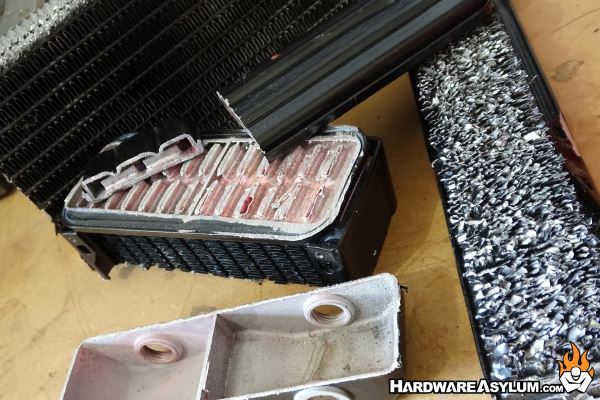Revisit Galvanic Corrosion and Improving Case Cooling

Hosts: Dennis Garcia and Darren McCain
Time: 30:22
Subscribe Options
RSS (MP3)
iTunes (MP3)
Spotify (Stream)
Amazon (Stream)
Originally recorded February 2021

Hosts: Dennis Garcia and Darren McCain
Time: 30:22
Subscribe Options
RSS (MP3)
iTunes (MP3)
Spotify (Stream)
Amazon (Stream)
Originally recorded February 2021
In this episode we dive back into the issues associated with Galvanic Corrosion. In the early days of watercooling there wasn’t a thing as “coolant for a PC watercooling loop” so, folks used everything from distilled water to automotive antifreeze. During this time enthusiasts and armchair zealots preached the gospel of “Galvanic Corrosion” as being the devil to all and promised to destroy your watercooling loop and leading to a katastrophic phailure.
During this time I remember a post on OC.Net where someone posted a photo of two Danger Den waterblocks and asked the forum to identify which one had been used with aluminum in the loop.
What nobody figured out (because everyone is clueless) is that one block had been sandblasted (a Danger Den staple) while the other was smooth machined. And wouldn’t you know it, everyone picked the sandblasted block as the culprit. Thing is, copper is not affected by Galvanic Corrosion in that way or would cause sandblasting pits in a copper block.
When Thermaltake released their TT Premium line of watercooling gear the Internet was in an uproar over their radiator selection. Not only was this new radiator super expensive but was made from 100% aluminum. This led to worldwide boycotts of the cooling gear because nobody believed it would last. Well, we are here to tell you that when matched with proper fluid an aluminum radiator will last years without damage and to prove it, we cut apart a TT Premium radiator that had been used for over 4 years 24/7 with a combination of copper and nickel in the loop while being matched with Thermaltake C1000 coolant.

Aside from some coolant stains it looks perfectly fine.
Improve Case Cooling
When shopping for a computer case there are several things to consider and all of which people ignore because nobody knows what to look for. The YouTube crowd loves to attack case manufactures for not providing adequate cooling while promptly ignoring that certain cases are designed for certain usages and not every case will fit their ideal situation.
While YouTube loves to create controversy. We like to prove that everything has a solution and all you need is to do a little work.
Cases are designed to be universal. There is no way that a case mfg will know exactly how many fans you plan to install or how hot your gaming build will be. What they know is that the market wants lots of fan positions, lots of storage space and tempered glass. So, to maximize how tempered glass is used in a build they remove as much metal as they can. They can then add fans to the build and a few places where you can mount storage drives. Nowhere in this requirements list is the need to provide proper airflow or even ensure that the fans will work properly.
This is where the builder needs to step in and start mapping out where air is going and where it is not. A fan sitting on a rack with open space all around will not move any air nor will create any pressure. Fans on a radiator may blow air back out the fan instead of pushing it through or leak air out the side. These leaks are why modern cases cannot cool and there is nothing the mfg can do about it.
But, you can!
Related Links
Lets open up a 4 Year old TT Aluminum Radiator
Episode 120 featured music:
Little People - Start Shootin' (http://www.littlepeoplemusic.com/)
 Personal ASUS ROG Build Process – Gaming hardware is not just for gamers
Personal ASUS ROG Build Process – Gaming hardware is not just for gamers Hardware Asylum Podcast Upgrades Powered by SilverStone
Hardware Asylum Podcast Upgrades Powered by SilverStone The Consumer Electronics Show 2025 - It was more than AI
The Consumer Electronics Show 2025 - It was more than AI A Look Back on 2024 Hardware Highlights and Bonus System Build
A Look Back on 2024 Hardware Highlights and Bonus System Build Extreme Reader Mail – Mystery Retro Hardware Unboxing
Extreme Reader Mail – Mystery Retro Hardware Unboxing An in-depth look at the ASUS ROG Crosshair X870E Hero Motherboard
An in-depth look at the ASUS ROG Crosshair X870E Hero Motherboard Impressions of the Questionable Borderlands Movie
Impressions of the Questionable Borderlands Movie More RTX 4070 Crazyness and some RTX 50 Series Leaks and Rumors
More RTX 4070 Crazyness and some RTX 50 Series Leaks and Rumors View All Episodes
View All Episodes